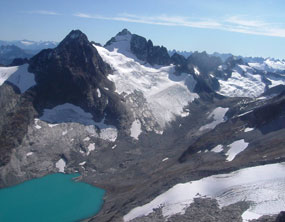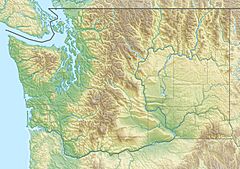Mount Spickard facts for kids
Quick facts for kids Mount Spickard |
|
|---|---|

Mount Spickard with Silver Glacier and Silver Lake
|
|
| Highest point | |
| Elevation | 8,980 ft (2,737 m) NAVD 88 |
| Prominence | 4,779 ft (1,457 m) |
| Geography | |
| Location | North Cascades National Park, Whatcom County, Washington, U.S. |
| Parent range | North Cascades, Skagit Range |
| Geology | |
| Age of rock | Tertiary |
| Climbing | |
| First ascent | 1904 by Walter Raeburn |
Mount Spickard (pronounced SPICK' erd) is a tall mountain peak in the North Cascades mountain range. It stands at 8,980-foot (2,740 m) (about 2,737 meters) high. This mountain is located in the state of Washington, in the U.S..
It's found very close to the border with Canada, only 2 miles (3.2 km) away. Mount Spickard is part of a smaller group of mountains called the Chilliwack Group. The rocks that make up Mount Spickard are mostly a type called gneiss. Water from its slopes flows into two big river systems: the Skagit River and the Fraser River.
Mount Spickard is known for its "prominence," which means how much it rises above the land around it. With a prominence of over 4,700 feet (1,400 m), it's one of the highest peaks in Washington state. The mountain has two smaller peaks near its main summit. It was named after a climber who sadly died while climbing a different mountain nearby. The first person to successfully climb Mount Spickard was Walter B. Reaburn in 1904.
Template:TOC limit=3
Contents
About Mount Spickard
Mount Spickard reaches 8,980 feet (2,740 m) high. It is located in the very northern part of North Cascades National Park. This makes it the 5th highest peak in the park. It is also the 16th highest mountain in the entire state of Washington.
Its prominence is 4,779 feet (1,457 m). This is the ninth-greatest prominence in Washington state. It also makes Mount Spickard the 70th most prominent peak in the United States. The closest taller mountain is Jack Mountain, which is about 19 miles (31 km) away.
Mount Spickard's Sub-Peaks
The main peak of Mount Spickard has two smaller peaks next to it.
- The taller sub-peak is 8,824-foot (2,690 m) high. It is about 0.3 miles (0.48 km) northeast of the main summit. This peak rises 304 feet (93 m) above the land around it.
- The shorter sub-peak is 0.5 miles (0.80 km) southwest of the main peak. It is 8,405 feet (2,562 m) tall. This peak has 364 feet (111 m) of prominence.
A famous climbing guide, Fred Beckey, called the northeast sub-peak "Peak 8824."
Connecting Ridges
High ridges connect Mount Spickard to other mountains.
- A ridge to the southwest links Spickard to Twin Spires (also known as Mox Peaks). It also connects to a ridge called the Ridge of Gendarmes.
- To the southeast, high ridges are broken up by glacier-couloirs. These connect Spickard to peaks like Tombstone Peak and Peak 7153.
- Another high ridge stretches to the northeast.
- The ridge to the northwest is broken by a low point. However, it continues for several miles. This ridge curves north and east around Silver Lake. It then connects to Mount Custer Ridge, Mount Rahm, and Devils Tongue.
Water and Glaciers
Mount Spickard and its nearby ridges have many glaciers. The Silver Glacier is one of them. It stretches for over a mile from Spickard's summit. It goes north through a large bowl-shaped area called a cirque to Silver Lake. The high land southwest of Mount Spickard has many glaciers. Some of these are very large. They extend over 3 mi (4.8 km) to Mount Redoubt.
River Systems
Water from Mount Spickard's slopes flows into four main river systems:
- Depot Creek flows west and northwest. It joins the Chilliwack River. This river eventually flows into the Fraser River. The Fraser River then empties into the Pacific Ocean in British Columbia, Canada.
- On the south side of Spickard, some small streams form Perry Creek. This creek flows east to Little Beaver Creek. Then, it goes into Ross Lake and finally the Skagit River.
- To the north, the Silver Lake Glacier melts. Its water flows into Silver Lake.
- Meltwater from glaciers on the east side of Mount Spickard also joins Silver Creek. Silver Creek flows east from Silver Lake to Ross Lake.
Getting to the Mountain
It is hard to reach Mount Spickard because the area is wild and far away.
- The easiest way to get there is from British Columbia, Canada. You can go via Chilliwack Lake and Depot Creek.
- There are two common ways to approach from Washington state. Both involve taking a water taxi on Ross Lake.
History of Mount Spickard
A geologist named Reginald A. Daly studied the Mount Spickard area in 1902 and 1906. He said that Mount Spickard and its neighbors were the hardest mountains to reach. This was true for the entire U.S.–Canada border area west of the Flathead River in the Rocky Mountains.
First Climbs
The first time someone climbed Mount Spickard was in 1904. This was done by Walter B. Reaburn. The next year, in 1905, Thomas Riggs Jr., George Neuner Jr., and J. Beall made a second climb. In 1906, Noel J. Ogilvie and a group from Canada also climbed Mount Spickard.
How the Mountain Got Its Name
Mount Spickard was called Glacier Peak until 1963. That year, it was renamed to honor Warren Spickard. Warren Spickard was a very skilled mountaineer. He died in 1961 while climbing a nearby mountain called Northwest Twin Spires (also known as Northwest Mox Peak). Warren Spickard himself had climbed Mount Spickard in 1955.


